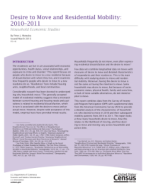Desire to Move and Residential Mobility: 2010-2011
Desire to Move and Residential Mobility: 2010-2011
Introduction
The residences we live in are associated with economic opportunities, health status, social relationships, and exposure to crime and disorder.1 This report focuses on people who desire to move to a new residence because of dissatisfaction with where they live, and it examines how frequently people who desire to move to a new residence do so. “Residences” here include housing units, neighborhoods, and local communities.
Considerable research has been devoted to understanding why households move.2 The generally accepted model of residential mobility suggests that a mismatch between current housing and housing needs and aspirations is related to residential dissatisfaction, which in turn is associated with the desire to move and an actual move. However, despite wide acceptance of this model, empirical tests have provided mixed results.
Households frequently do not move, even after expressing residential dissatisfaction and the desire to move.3
Few data sets combine longitudinal data on moves with measures of desire to move and detailed characteristics of respondents and their residences. This is the main difficulty with studying desire to move and residential mobility. Moreover, having the desire to move is not the same as having the intention to move. Some households may desire to move, but because of socioeconomic status, physical health, family and social ties, or lack of more suitable alternatives, do not intend or plan to move.
This report combines data from the Survey of Income and Program Participation (SIPP) with supplemental data from the American Community Survey (ACS) to provide a detailed analysis of the characteristics of householders who desired to move in 2010 and their subsequent mobility patterns from 2010 to 2011. The report looks at how many households desire to move, how this relates to the likelihood of moving, and how desiring to move and moving vary across households and across time.
_______________
1 See Tama Leventhal and Jeanne Brooks-Gunn, “The Neighborhoods They Live In: The Effects of Neighborhood Residence on Child and Adolescent Outcomes,” Psychological Bulletin, 2000, Vol. 126, pp. 309–337; Ana Diez Roux, “Investigating Neighborhood and Area Effects on Health,” American Journal of Public Health, 2001, Vol. 91, pp. 1783–1789; Robert Sampson, Jeffrey Morenoff, and Thomas Gannon-Rowley, “Assessing ‘Neighborhood Effects’: Social Processes and New Directions in Research,” Annual Review of Sociology, 2002, Vol. 28, pp. 443–478.
2 See Peter Rossi, Why Families Move: A Study in the Social Psychology of Urban Residential Mobility, The Free Press, Glencoe, IL, 1955; Alden Speare Jr., “Residential Satisfaction as an Intervening Variable in Residential Mobility,” Demography, 1974, Vol. 11, pp. 173–188; Nancy Landale and Avery Guest, “Constraints, Satisfaction and Residential Mobility: Speare's Model Reconsidered," Demography, 1985, Vol. 22, pp. 199–222.
3 See Barrett Lee, R.S. Oropesa, and James Kanan, “Neighborhood Context and Residential Mobility,” Demography, 1994, Vol. 31, 249–270; Gordon De Jong, "Choice Processes in Migration Behaviour," in K. Pandit and S.D. Withers (eds.), Migration and Restructuring in the US, Rowman and Littlefield Publishers, New York, 1999, pp. 273–292; Max Lu, “Do People Move When They Say They Will? Inconsistencies in Individual Migration Behavior,” Population and Environment, 1999, Vol. 20, pp. 467–488.
Others in Series
Publication
Publication
Publication




